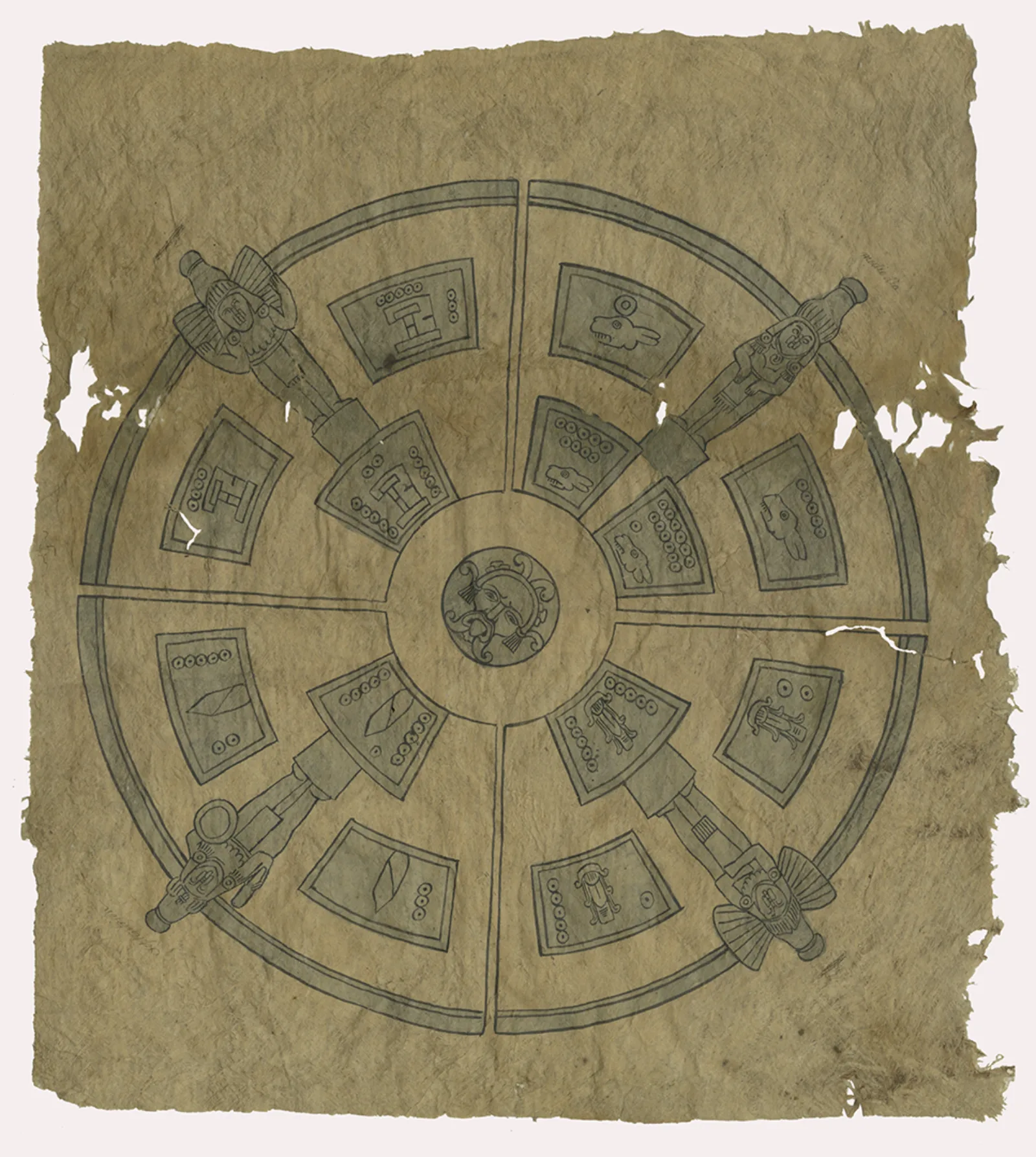This Mexican calendar wheel is a striking example of the rich and diverse materials included in the Newberry's Ayer collection. Its history, however, is one with numerous uncertainties and provides a glimpse into the complicated and fraught relationship between European colonizers and the Indigenous people of Mesoamerica. The wheel is one of ten Indigenous pictorial documents acquired by artist and explorer Jean-Frédéric de Waldeck during his travels in Mexico in 1831. It was part of the 1911 gift of Indigenous materials to the library by Newberry trustee Edward E. Ayer.
The calendar wheel depicts the thirteen fundamental numerals of the divinatory calendar (the day cycle from 1-13) and the four symbolic glyphs representing the beginning of a year in Nahuatl, one of many Indigenous languages still spoken in Mexico and Central America. Each glyph corresponds with the four cardinal points: Acatl (Reed) = East, Tecpatl (Flint) = North, Calli (House) = West, and Tochtli (Rabbit) = South. The four represent bearer years that allowed for 52 beginnings of the year. A complete cycle of 52 years made up what is sometimes called a Mexican century.
In addition to works acquired by Waldeck, the Newberry’s collections include Waldeck’s own original artwork of his depictions of Mesoamerica. The collection consists of more than 200 artist-proofs, lithographs, and drawings, including Waldeck’s drawing of the calendar wheel.
Who Was Waldeck?
Jean-Frédéric Maximilien de Waldeck (March 16, 1766? – April 30, 1875) was a French antiquarian, cartographer, and artist. He was a man of talent and accomplishment, but his love of self-promotion and refusal to let the truth get in the way of a good story leave some aspects of his life in mystery.
Waldeck's first contact with the art of Mesoamerica was when he was hired by the publisher Henry Berthoud to prepare some plates for an 1822 book entitled Description of the Ruins of an Ancient City. This book was an English translation of the 1787 report on Palenque by Antonio del Río which had been commissioned for Charles III of Spain and then sat unpublished in the National Archives of Spain.
Waldeck's engravings have often been described as much more beautiful and artistic than the original drawings he worked from, and gave the monuments a decidedly Egyptian look, in line with the problematic view that Mesoamerican Indigenous Peoples were the Lost Tribes of Israel.
Controversy
Waldeck’s illustrations of panels of Maya script in the Temple of Inscriptions at Palenque included clear depictions of heads of elephants. We now know these to be erroneous embellishments as elephants are not native to the Americas. This fueled speculation about contact between the Maya and Asia. It also played into the misconception that the mythical lost continent of Atlantis was a common link between civilizations in the Americas and elsewhere.
It is believed German engineer and architect Carl Nebel served as a middleman for Waldeck and made the calendar wheel available to him in return for several drawings Waldeck had done for Nebel. The original mounting for the ink on native paper calendar wheel includes its size, price paid, and notation by Edward Ayer stating, “Bishop Plancarte does not think the calendar is made by Indians.” Bishop Plancarte was a theologian, historian, and archeologist. He taught at the seminary in Mexico City and made excavations at various sites in Mexico. In all, he amassed more than 2,800 objects that now form the Plancarte collection at the National Museum of Anthropology in Mexico City.
The calendar wheel, along with the Conquest of Azcapotzalco, also acquired by Waldeck and in the Newberry’s collections, are listed in John Glass’ “A Catalog of Falsified Middle American Pictorial Manuscripts” in the Handbook of Middle American Indians (HMAI). By HMAI’s definition, a falsified manuscript is “...identified mistakenly as a genuine preconquest of colonial Middle American Indian document painted in the style and with the iconographic forms of the native tradition."
You can see the calendar wheel in our current exhibition, Wheels, on view through September 23.
About the Authors
Jo Ellen McKillop Dickie is Reference Services Librarian and Selector for Reference. Analú López is the Ayer Librarian and Assistant Curator of American Indian and Indigenous Studies at the Newberry.
